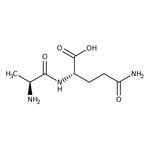Search Thermo Fisher Scientific
L-Alanyl-L-glutamine, 99%, Thermo Scientific Chemicals



L-Alanyl-L-glutamine, 99%, Thermo Scientific Chemicals
Chemical Identifiers
Specifications
Description
This Thermo Scientific Chemicals brand product was originally part of the Alfa Aesar product portfolio. Some documentation and label information may refer to the legacy brand. The original Alfa Aesar product / item code or SKU reference has not changed as a part of the brand transition to Thermo Scientific Chemicals.
General Description
• L-Alanyl-L-glutamine is a synthetic dipeptide that degrades to L-glutamine
Application
• L-Alanyl-L-glutamine can be used as a substitute for glutamine in mammalian cell culture media and is stable to heat-sterilization
• It is a stable Gln dipeptide, which protects mice against the jejunal crypt depletion in the setting of dietary protein and fat deficiency
• It improves pancreatic beta-cell function, maintaining the mitochondrial metabolism and stimulus-secretion coupling essential for insulin release
• When this dipeptide is added to cultures of antibody-producing CHO cells in vitro, it reduces apoptosis and promotes antibody production